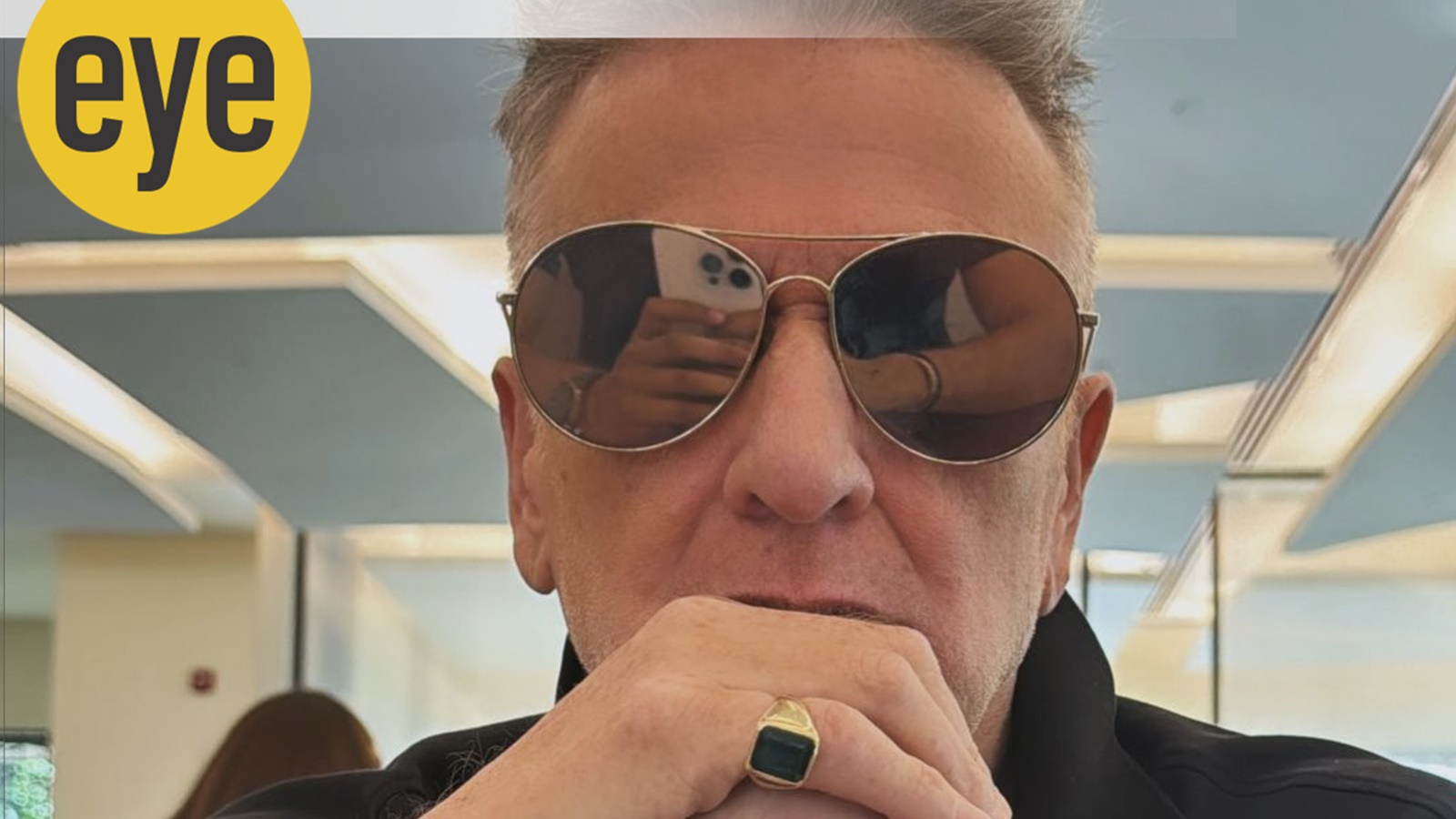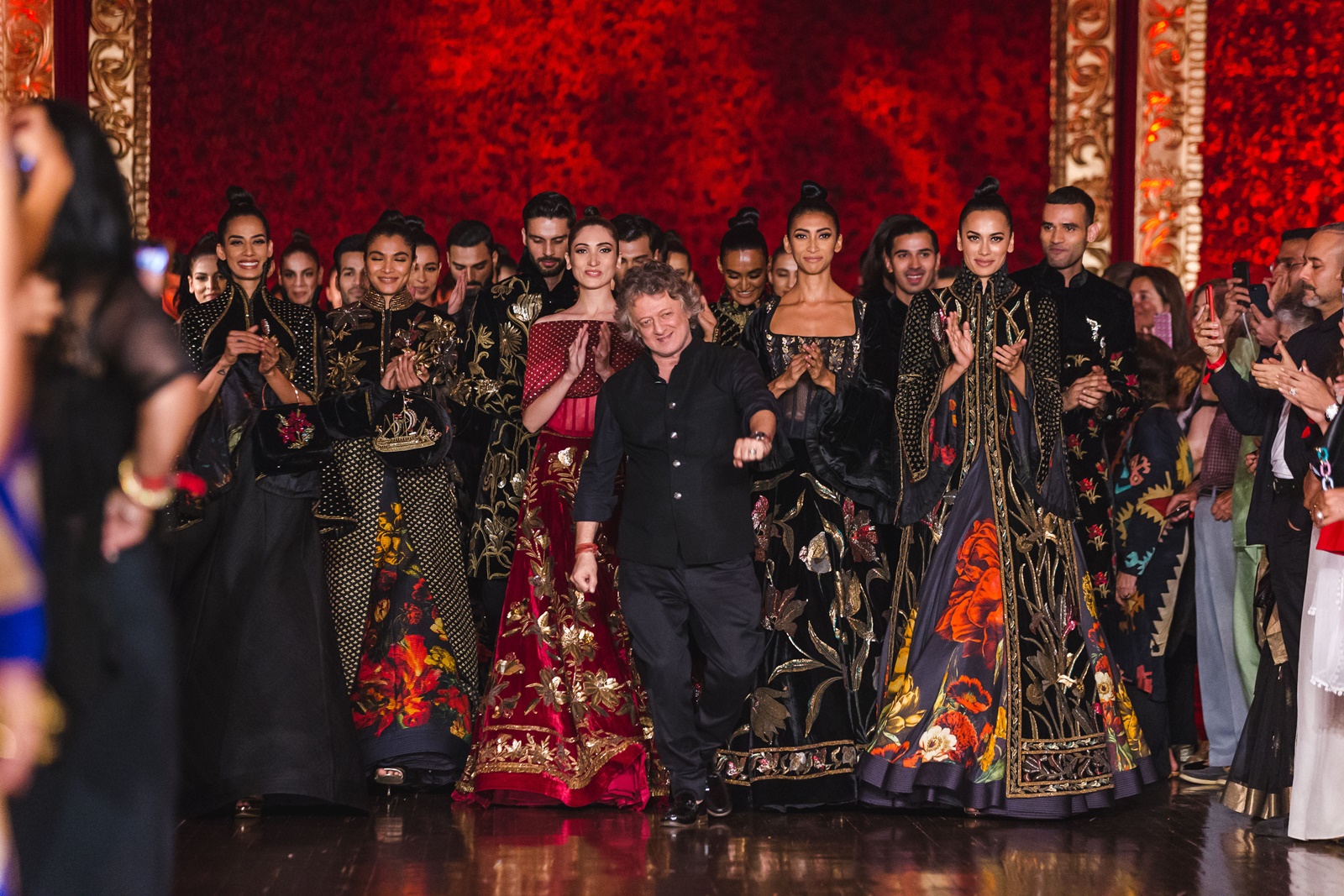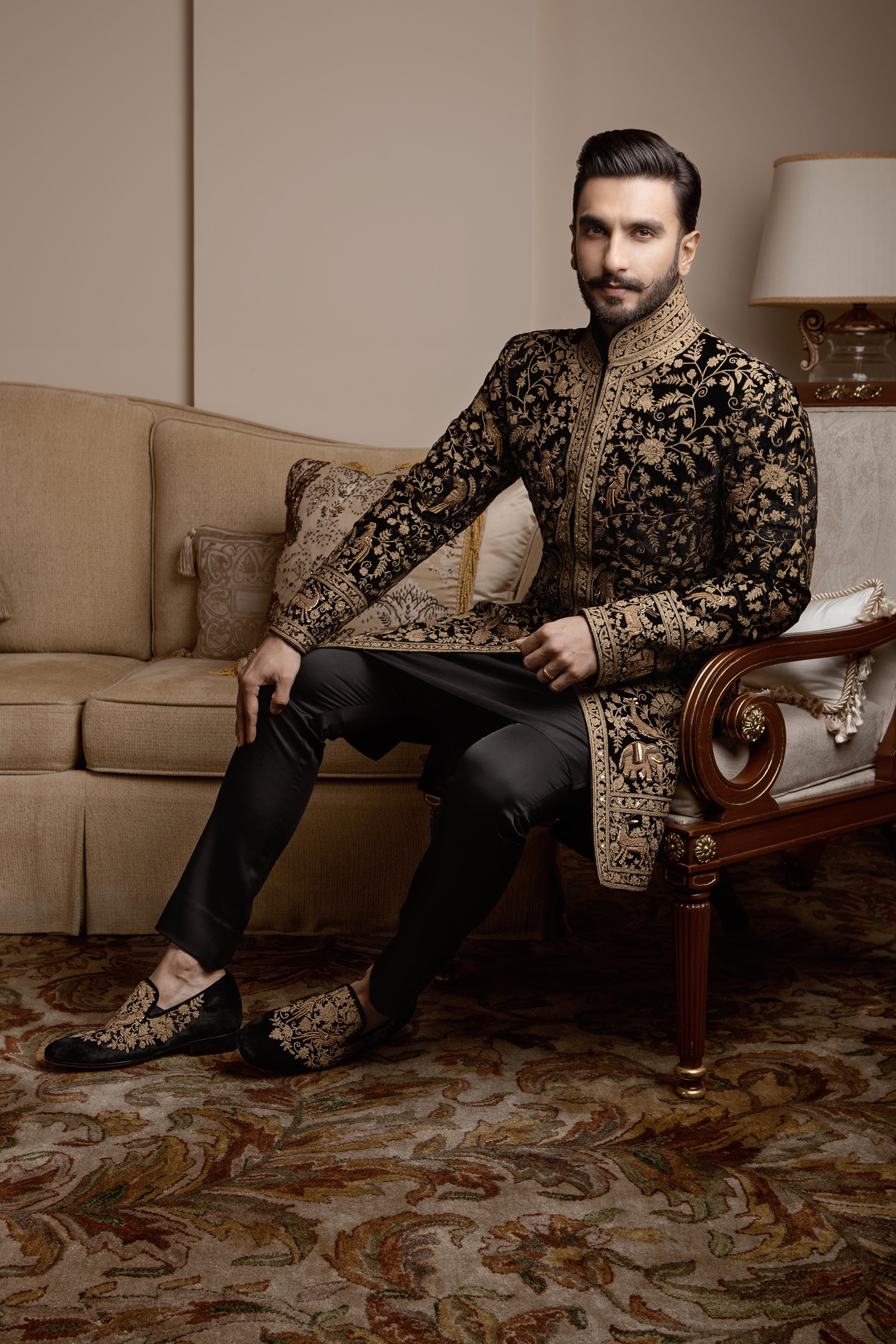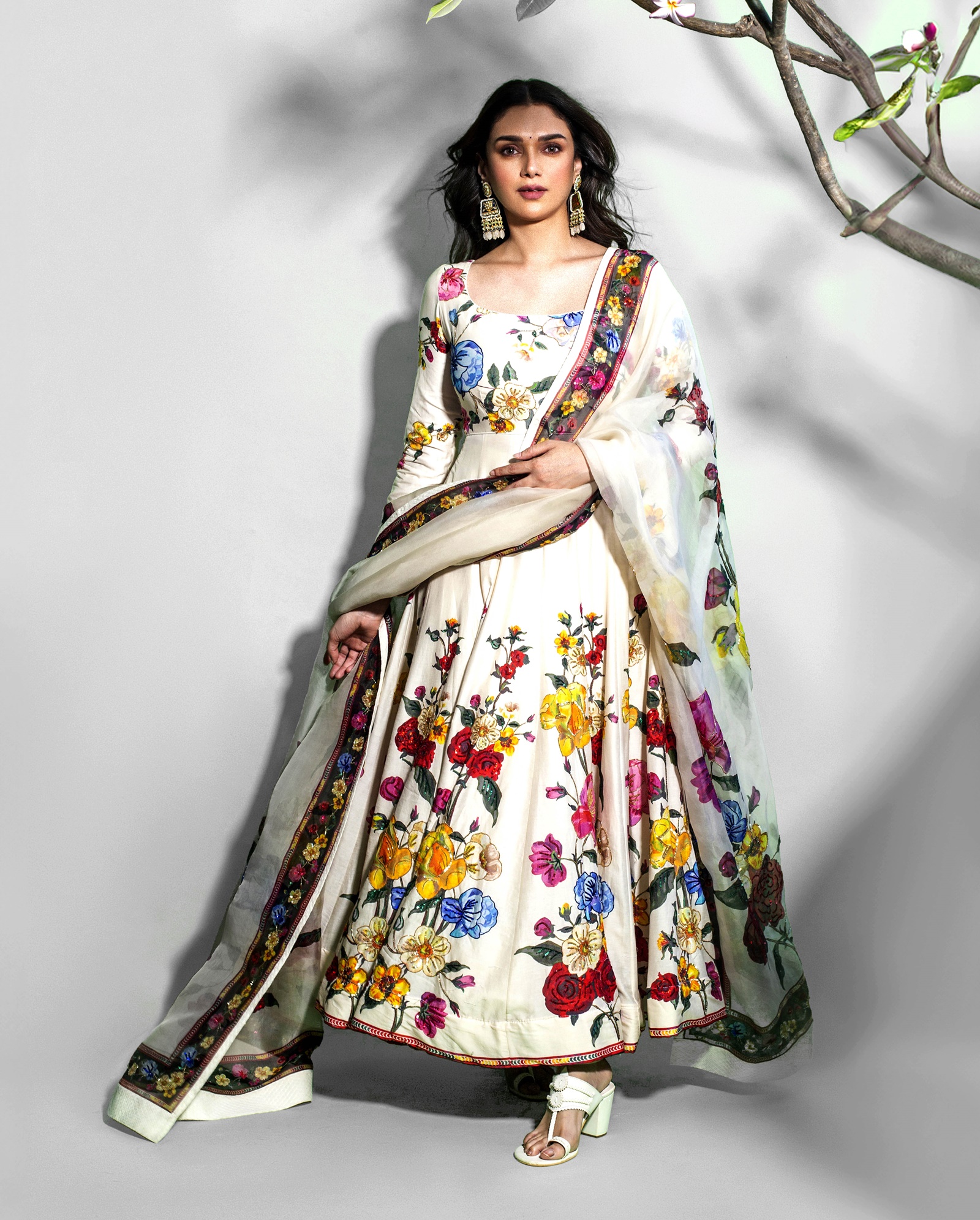Fashion
How Rohit Bal is packing a punch, all over again: ‘Good fashion is not about a bellowing 15-metre trail’

There’s something comfortingly reassuring about this Abba hit as you enter the workspace of fashion designer Rohit Bal at his store in Delhi’s Defence Colony. That the chorus should play just before we are to meet is nothing short of a metaphor for the artist’s brush with life and death over the last few years as he battled heart disease and kept going in and out of hospitals. But my, my, how can the enfant terrible of Indian fashion resist life itself? And so, clad in his trademark black T-shirt and blue jeans, he hums, “Hey, here I go again,” with a fist bump.
There was a time last November — Bal was admitted in ICU in a critical condition and put on ventilator for a longish spell — when doctors were a worried lot. He already had a compromised heart after an angioplasty in 2010 and other complications. Recovery seemed a distant prospect, but Gudda, as he is lovingly called by fashion industry peers, walked out of hospital, pale and frail, but more determined to leave his stamp on the world. Some colleagues had written him off, but at 63, white-haired and much wizened, the man has never been more in control of his life and legacy as he announced his return with a gratitude post on Instagram. “Let’s not talk about my hospital days, it has been four months, I have left them far behind, I’m here in the now,” he says.
He’s just come back from his unit in Noida, where he’s working with his design team and kaarigars on his new collection of summer florals. “I am doing things on my own, even Insta posts,” says Bal, his eyes sparkling as he gives instructions to the sales team and guides a young bride and groom. These days, he gets quickly exhausted, settling into a recliner and needing cups of green tea. The old recklessness is gone, he’s more measured, patient and cleaned up but that’s only to keep his passion alive in a healthy body. “That’s what shows in my work, that’s what people remember you by, not by how much you lived,” he says. Now he’s given up alcohol, smoking and red meat, fasts once a week, doesn’t miss his physio sessions and goes for the ayurvedic cleansing ritual of panchkarma in Kerala.

Bal is a survivor, having begun in 1991 and having multi-generational families as his loyal customers, many of them corporate bigwigs and top names of Bollywood. That’s because he has contoured an identity for Indian fashion as it is today. If Rohit Khosla can be credited for shaping couture in India with his first label in the late 1980s, then Rohit Bal, who took up history at St Stephen’s before he was drawn to NIFT (National Institute of Fashion Technology), should be credited for carrying it forward after Khosla’s death in his 30s. Unconsciously enough, he gave the luxury tag to Indian wear, accommodating the richest of our craftsmanship and heritage fabrics into a Western silhouette and its subtle grammar.
As a student of fashion history, he effortlessly marries tradition with his individual talent and wearability. Fashion to him is an artistic tool, like a bird in flight, extending his wingspan and showing off his plumes. On one side are the bellowing crepe layers under full-sleeved royal English coats, ruffled collars and some puffed elf sleeves. On the other, there’s the simplicity of white, simple cuts, and the clean lines of the sherwani and the sari. And then there are the embroidered motifs in stunning colour combinations in between. “An original does not change and I am here from 1992. My soul is Indian, so I am going to put my weavers and craftsmen first. My dream is to have a huge karkhaana (factory) of craftsmen, so that our creative legacy can be preserved,” says Bal, as he plans to travel to Banaras for a session with his weavers.
“For over 30 years now, I keep going back to Banaras, just to see weavers finish three inches of a saree border in 24 hours on their wooden looms in almost 50-degree heat. The loom fills up his quarter and the weaver wraps his life around it, worshipping it almost. Sipping tea and sharing food with them were my real student years of understanding India’s hand-made traditions. The carpet weaver takes months and years to finish a piece and then lugs all 40 kg of it on his cycle, going door-to-door, hoping somebody will buy it. The shahtoosh, which used to be made from the underfur of the Chiru (Tibetan antelope) had to be pieced together manually, sometimes over a year. Human hair is about 70 microns, and the fur is somewhere between 13-19 microns. That’s how delicate it is. Only young weavers could work on them with their nimble fingers, keeping the fabric on their knees. Imagine their dedication to something that might not have given them instant income. It’s a labour of love,” says Bal, who doesn’t display the most expensive Italian crystalware he’s been gifted but puts the smallest hand-crafted box from Dilli Haat on his shelf.

That’s why he gets upset when anybody disrespects the unconditional love that any artist has for his work. He recalls how he had burnt the shawl a woman was wearing at a winter bonfire simply because she was bragging about its hefty price tag. “She thought it was a collectible because it was expensive, she did not value the shawl maker. I just took it off her and threw it into the fire,” he says.

As the third cup of green tea warms him up, the no-holds-barred Gudda comes to the fore, the one who broke the stiffness of an exclusionary elitism. “Couture is the price of skill and artistry but that doesn’t mean that skill cannot be all-encompassing. I look at a person, see what they are wearing and know what their comfort and flair are about, where they are coming from. My job is to express that language through my works,” he explains. That’s the reason he’s stayed away from the familiar terrain of Bollywood endorsements despite being one of the first designers to do outfits for Kaun Banega Crorepati. And he did dress up Deepika Padukone for her debut Cannes outing in an elegant ivory white sari in 2010. But he never overplayed this card.
That’s why Bal is a man of several firsts. He elevated menswear and was one of the movers behind the Men’s Fashion Week. Then came the embroidered patches — long-tailed parrots, elephants, cockatoos, horses, flowers and leaves — in sherwani jacket corners, pleats, lapels, borders, cuffs and on churidaars, lending a touch of casual extravagance and metrosexuality. He was the first mainstream designer to put out a pret line of khadi shirts for men at Rs 400. He was first among peers to patent and copyright his collections. Instead of French fashion houses, he collaborated with Indian brands like HiDesign, Titan and Biba for pret collections, his own pret line, Balance, coming many years later. And way back in 2004, he knew that post-millennials would be aspirational from their growing up years and conceived the brand Bal Bachche, with bandhgalas for boys and mini lehenga-gowns for girls. It was launched in 2021.
His critics say that for all his pioneering work, he is a monopolist and is losing out to younger designers, who have entered into smart tie-ups with corporates like the Aditya Birla group and Reliance, and are growing their business and international footprint. To Bal, that’s about taking shortcuts and insecurity. “When you sell out to corporates, you are at their beck and call. They want ROI (return on investment) and will keep you in a chokehold. That stifles creativity. I don’t want to wake up at 7 am with a phone call, reminding me about bottomlines. I command my time and get value for it, on my terms. I don’t want to be a 49 per cent owner,” he says.
In fact, Bal is known to have turned down such corporate offers on the phone itself. He would rather they endorsed weaver collectives instead of buying designer labels. That’s why he disapproves of the latest obsession with chintz. “Didn’t calico printmakers already do this? Why not push our block prints instead? Look within, not without,” he says, circling his fingers around his heart. “Fashion has to be ethical to survive,” he adds.
Corporatisation, he believes, has taken the charm out of fashion shows. “I did watch a couple of fashion shows and the retail boom means that every designer is creating almost similar pieces. There was a time when we had to get to work months before a showing, submit at least six samples for the collection to go on the ramp. Now anybody gets a showcase without the rigour,” he says.
An avid surfer of the goings-on in the fashion industry, he is acerbic about how the Met Gala has sounded the death knell of aesthetics and become a soulless parade of trophy art masquerading as esoterism. “The models couldn’t breathe and would have tripped over a bellowing 15-metre trail had they not been helped or lifted by their staff. That’s called imposing fashion, not owning it. Why do Indian labels have to follow that same look? You want regalese, just adapt what women wore in the Chola and Pallava dynasties. Such richness in their individualistic looks, from coiffure, kohl, to jewellery and drapes. And they were functioning women. Did they need a trail? But then you can adapt only when you know history, don’t you,” counter-questions the man known for his smart silhouettes and not hiding behind volume or drapes.

He has a problem with outlandish concepts because of their percolation at the mass level. “Suddenly you will see a surfeit of bling, metal and beads, so overdone that you cannot even hug the wearer for fear of hurting yourself,” he says, laughing out loud. “Over-the-top embellishment and drama are simply bad fashion. Good design is about knowing when to stop,” says Bal, who never allows an extra tendril or bud in his floral motif if it doesn’t sync with the symmetry of design.
It is because of this curatorial eye that Bal sees no threat from Artificial Intelligence. “You can feed AI 40 designs of mine and it will give you nth number of permutations and combinations. But it won’t give you the 41st that is still in my head or the 401st that I have not thought about yet,” says Bal, who, despite marketing advice, refuses to open stores abroad. “I want the world to come to me here. I want my people to buy their clothes here, feel and respect the garment,” adds the designer who is now planning to fan out in Tier 2 cities, beginning with Nagpur and Hyderabad, an “elegant city” in his words.
This clarity of vision to know when to change course is what has kept his brand alive in a saturated market. That’s why he is secure, happy to root for fellow designers from the sidelines, standing like any other guest or cameraman at their shows. For all the people he groomed, not many have hung around to see him through his illnesses but he has no grudge. “I can give all of this up and sit under the chinar tree, watch the falling leaves for hours and try to catch them in my imagination…such is the art of doing nothing,” he says. And so he does, choosing to create when he wants to, not because he has to.
Will we see him on the ramp again? “My shows are like a theatre production. Maybe in September, with havelis and music,” And he would never care for bravos, as long as he had created a magic moment. “That’s it,” he would say, dancing in the dark.








:max_bytes(150000):strip_icc()/roundup-writereditor-loved-deals-tout-f5de51f85de145b2b1eb99cdb7b6cb84.jpg)


